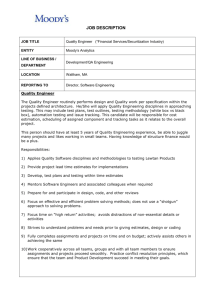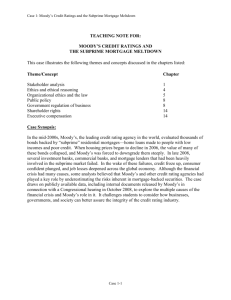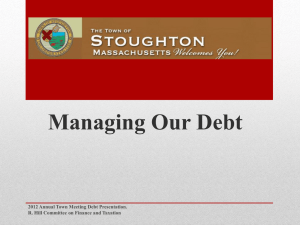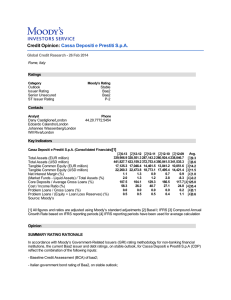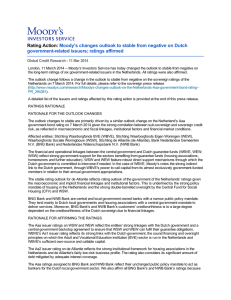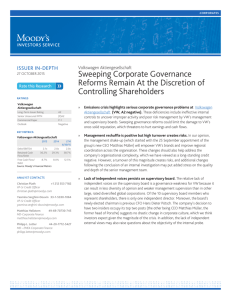Group presentation
advertisement
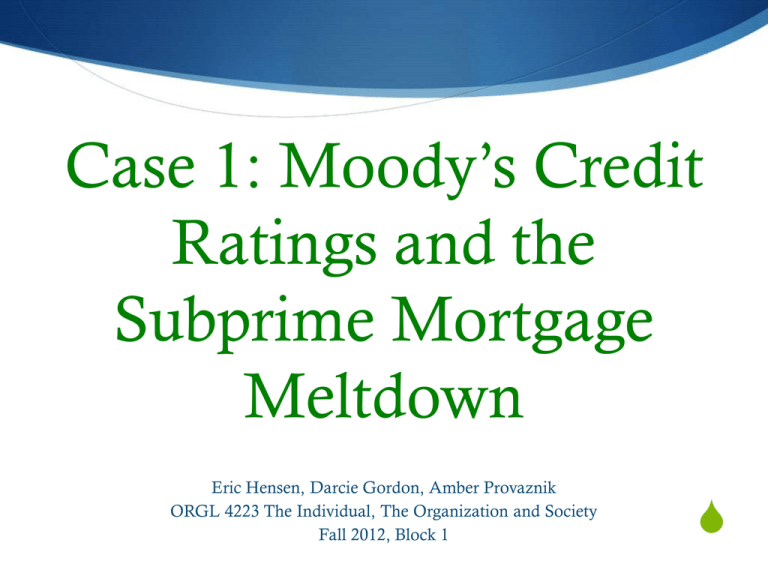
Case 1: Moody’s Credit Ratings and the Subprime Mortgage Meltdown Eric Hensen, Darcie Gordon, Amber Provaznik ORGL 4223 The Individual, The Organization and Society Fall 2012, Block 1 S Case Summary Moody’s is the oldest credit rating agency in the world, founded in 1909. Moody’s core business model was in the area of rating bonds for businesses, specifically the likelihood of their return. This allowed investors to evaluate the risk of their chosen endeavors. However, eventually Moody’s business model changed. They began rating more than just corporate bonds, moving into residential mortgage-backed securities.. These securities were bundled together in a mixture of high risk and low risk mortgages, allowing them to charge higher fees and higher interest points than that of traditional corporate bonds. This lead to an increased amount of money in the early 2000’s for investors to dump into retirements, hedge funds and pension plans. As a result, the demand for these securities increased as mortgage lenders were pressured into granting loans to under qualified home-buyers. The push for an America latent with proud homeowners was another contributing factor. Eventually, it became apparent that homeowners were faltering on their loans and the real estate market plummeted. Moody’s then began rating the securities at subprime levels and investors were losing value in their holdings. Moody’s stock dropped and after much public criticism, the House of Representatives got involved. A hearing with Moody’s revealed a huge disparity in the responsibility of this financial crisis. Discussion Question 1 What did Moody’s do wrong, if anything? Answer Moody’s failed in regulating the pressure put on mortgage lenders. Although Moody’s was only responsible for rating the loans and the associated risks, Moody’s was fully aware of the effect these bundled tranches were making on the lending process. Moody’s took advantage of a lucrative process without forwardly thinking of the consequences. Their primary goal was pleasing the investors, which they themselves were often personally involved with as well. There’s no doubt that some of the ratings may have been padded somewhat in order to make the investment packages look more appealing to potential investors, even though the packages were made up of high risk, under qualified home-buyers. Moody’s may not be solely to blame for this financial crisis and the crash of the real estate market but they certainly played a part. There weren’t any indications of efforts made to alter the outcome of what was obviously a short-term success. Discussion Question 2 Which stakeholders were helped, and which were hurt, by Moody’s actions? Answer S The stakeholders that benefited most from Moody's actions were the homebuyers that did not traditionally qualify for a mortgage. Also, investors benefited from the poor credit ratings that Moody's assessed because millions of investors relied on them for an independent and objective assessment. Wall Street benefited greatly because the lender packaged thousands of mortgage- backed loans and sold them to investment banks like Lehman Brothers and Merrill Lynch. Finally, mortgage brokers benefited because they received commissions for selling the riskiest loans that carried high fees. S The stakeholders that were hurt by Moody's actions were the good paying homeowners whose homes lost value, therefore couldn't sell or refinance because of all the defaults from subprime homeowners. Discussion Question 3 Did Moody’s have a conflict of interest? If so, what was the conflict, and who or what were the principal and the agent? What steps could be taken to eliminate or reduce this conflict? Answer S Moody's had a conflict of interest contrary to what Mr. McDonald stated when he was under oath speaking to the House of Representatives on Oversight and Government Reform. Their business model put investors interests first. Moody's was in competition with other credit rating agencies like S&P and Fitch, so to get lenders to use their services, Moody’s had to lower ratings. Also, Moody's was asked to rate the creditworthiness of various tranches of the mortgage-backed securities. Investors had no clue how to assess the safety or security of products because most products were grouped and sold in shares to investors. Moody’s needed to rate these products and give a professional opinion of the risk. S As difficult as it may be, the best way to prevent or reduce conflict of interest is for the SEC (Securities and Exchange Commission) to change the relationship between the bond issuers and the rating agencies. Issuers should not have a strong incentive to shop for the best rating. Additionally, the House of Representatives Committee on Oversight and Government Reform needs to aggressively audit the credit rating companies, investors, and lenders to make it as transparent as possible. Discussion Question 4 What share of the responsibility did Moody’s and its executives bear for the financial crisis, compared with that of home buyers, mortgage lenders, investment bankers, government regulations, policymakers, and investors? Answer Everyone including Moody's played a large roll in the financial crisis. The home-buyers were told to lie in order to qualify for the loan since no one would verify their information. The mortgage companies made loans to people and then bundled them together to sell to investment banks so that the mortgage lender had cash for more loans. The investment banks would then create a special kind of bond so the people who bought the bonds would receive a portion of the mortgage holders monthly payments. The policymakers and government regulators had big agendas for making everyone a homeowner, regardless of credit, income, or down payment. The agenda was to make it look like they were helping America become the land of homeowners. Moody’s found out how lucrative rating structure loans could be and began rating them even though that was not the business they had begun or been doing. They only saw the money and realized that the bigger structured loans they rated, the more money they made. Moody’s always gave good ratings because they wanted people to continue to use their services in order to continue making money. They all played a part in this game, therefore are all equally responsible for the financial crisis. It wasn't just one person who was doing wrong. It came apart one block at a time. Discussion Question 5 What steps can be taken to prevent a recurrence of something like the subprime mortgage meltdown? In your answer, please address the role of management policies and practices, government regulation, public policy, and the structure of the credit ratings industry. Answer In order to prevent another sub prime mortgage meltdown, the government needs to have more regulation. It needs to be part of the process starting with the mortgage and carrying through to the investors. The structure of the credit rating industry should be evaluated and public policy made as to what will and will not be done and how each step will be carried out. Public policy will have to be in every part of the process to ensure that each step is transparent enough to see when something is fishy or unbelievable. The management polices and practices will have to revert to those of the pre- "housing for everyone fad". The policies will have to ensure the person can qualify for the loan, and possesses the necessary credit, down payment and income to prevent default on the loan. Rating companies like Moody's need to tightly regulate and revert back to the company that cannot change for the ratings they are giving. Then, it would be of no benefit to lie about the ratings because they would have nothing to gain. It will take everyone doing something to ensure no more sub prime meltdowns. References S Lawrence, A.T., Weber, J. 2011. The Meaning of Corporate Social Responsibility. Business & society: stakeholders, ethics, public policy (13th ed.) (pp. 50). New York: McGraw-Hill/Irwin.
